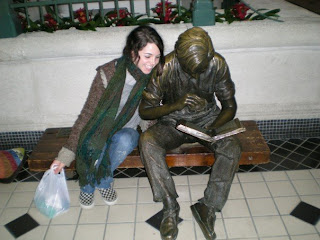
I am proud, relieved and amazed that the NSU student media posse has arrived at the conference intact and in good spirits. Getting here was truly an accomplishment -- and an adventure.
We met before dawn in a fog-filled parking lot on campus before heading off in a caravan of carpools to the Shreveport airport. Just a few hours earlier, I had run into Jim after midnight at Wal-Mart, and I had seen many of the conference-goers at Kyser even later than that, as they worked most of the night putting the paper to bed. At 4 a.m., when Kera walked back into the newsroom to pick up her phone and I was still in my office trying to finish up paperwork, I really wondered if some of us (meaning me) would have to go to DC with just the clothes on our backs.
Getting to Shreveport was only the first leg of a long day of travel. Lauren, Jim and Mary had to fly standby all day because the flights they were booked on were much later than the rest of the group, and we were determined to arrive en masse. Luck was on our side, and at the last minute, our three standby passengers snagged the last three seats on our flight to Dallas.

Our good fortune seemed to shine on in Dallas, where Jim, Lauren and Mary immediately hustled over to a flight already boarding and once again were able to grab the last few seats off of the standby list for a packed flight, this time to DC. While they were winging their way east, the rest of us boarded another flight and learned that our pilot was running late to the airport. By the time we finally left, I had read the Entertainment Weekly I bought in DFW from cover to cover and annoyed my seatmates with a growing pile of discarded newspapers.
Our group reunited upon landing at Reagan, and we set off to the Metro for our first foray into DC. I now know what it's like to have an entourage. I was the leader of a wheelie-pulling Gen Y gang, thundering through the turnstiles and taking up excessive extra space on the Metro system at rush hour. After emerging at Dupont Circle, we headed on foot for the Hilton Washington, allegedly a few short blocks away. My entourage and I hiked (trudged) several long blocks
uphill, through a steady drizzle, flirting with scolosis and wrist sprains from schlepping bags. When the blue Hilton "H" finally came into view, I asked Andi if it was a mirage. She confirmed that it was real; we had indeed arrived!

The lobby of the hotel was chaos, with every seat and square foot occupied by gaggles of college kids in various states of hanging out or checking in. As I made my people hang out while I checked us in, I took stock of the scene. Sure, we were a soggy, bedraggled bunch without the requisite matching luggage and garment bags in school colors -- but I was incredibly proud to have brought every single one of these student media leaders to the ACP/CMA conference. Standing there, I felt the collective energy of hundreds of ambitious, earnest and enthusiast journalism students. Watching everyone, I felt excited about the contribution that NSU makes every year in adding to this congregation. Looking around, I felt old.
Dr. Lee






























